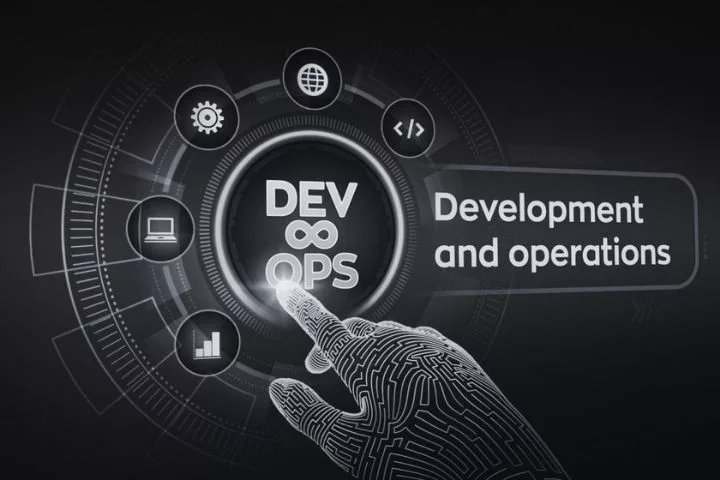What Is DevOps? And What Are The Methods In it?

DevOps is an artificial word that is sum of the terms Development (Dev) and Operations (Ops). DevOps thus adds two organizationally separate IT areas: Software development and IT operations.
Why DevOps?
The DevOps movement arose out of the market demand to increase product quality and complete projects on time. Customer expectations are becoming more and more demanding, and companies are increasingly forced to act.
However, while the development relies on agility and strives for constant optimization of the existing systems, the operation is based on stability.
The company pursues the goal of maintaining software, infrastructures and system landscapes as stable as possible.
The teams remained isolated and only dealt with their areas of responsibility and – of course – their own goals and values.
The innovative method is implemented by integrated IT teams that take responsibility for the development and operation of applications. The team thus supports the entire software lifecycle.
These two specialist departments can benefit immensely from each other and allow their expertise to flow into the respective teams.
In this way, the development of high-quality products can be accelerated, and reliable operation can be guaranteed.
Goal of DevOps
DevOps aims to respect and maintain the organizational separations and make the software development more efficient and reliable by adapting the processes.
In addition, the department is directly integrated into this approach, which enables faster approvals and deliveries in connection with agile methods.
DevOps is, therefore, a process improvement approach that is intended to optimize the entire software development process and thus offer fast and efficient services to the entire business.
DevOps components
DevOps is to be understood as a corporate culture that takes a holistic approach. To be able to achieve more efficient cooperation and a better quality of the end product, the four components teams, tools, methods as well as transparency & stability are aligned:
Teams
The aim of DevOps is that all project participants support each other and enrich the entire team with their skills and knowledge.
The knowledge should therefore not be “hoarded” in the individual areas – head monopolies are avoided.
In addition to the main players in software development and IT operations, employees from specialist areas, the test department and support can also support the team with their specialist knowledge.
These integrated teams have the advantage that the necessary expertise is available directly in the team and does not have to be laboriously inquired about – the spatial proximity results in faster communication channels.
In addition, required approvals can be issued directly from the team. The result:
- Faster time-to-market,
- high delivery reliability,
- the company company’s expectations can be precisely met,
- the end product receives improved support.
Tools – automate processes.
Tools should relieve us humans of standard tasks. In a first step, recurring tasks must be identified in a process, which should then be left to the machines in a further step.
The use of tools that are supposed to do those tasks automatically is aimed at every phase of the software lifecycle.
These tools should not be detached from one another but should interact as much as possible and form a toolchain. Ultimately, as many steps as possible should be done automatically. This is how machines could
- Execute build processes directly after the use of new codes (Code deployment),
- Automatically provide artifacts in the respective environments,
- automatically run tests and report the result to those responsible,
- Automatically monitor the status of the infrastructure and applications,
- Make decisions to adapt the infrastructure/applications based on defined threshold values.
DevOps itself is not a tool, but different software tools form important building blocks for the automation and implementation of the products. The customer’s infrastructure often already offers the basic prerequisites to carry out the approach without any problems.
Methods in devops
DevOps is methodical on both a technological and a procedural level and puts classic ITIL processes to the test. The innovative DevOps concept now envisages “breaking out” of standardized procedures, posing challenges for companies with stable process frameworks:
- Continuous Integration
- Continuous Delivery
- Continuous Deployment
- Integration into existing processes
Continuous Integration
Continuous integration is a method in which components are continuously combined to form an application.
The software quality is to be increased through continuous integration. Artifacts are used to represent product components so that the components of the product can be seen transparently by all team members.
Continuous Delivery
Continuous delivery is the second step, building on continuous integration. Continuous delivery aims to deploy the previously automated artifacts (also) automatically.
Continuous Deployment
Continuous deployment means that builds are automatically imported into the production environment. Continuous deployment is the last expansion stage and can only be used meaningfully for selected software developments.
Continuous Monitoring
Continuous monitoring allows insight into the performance and integrity of the entire application stack in real-time.
With the help of extensive telemetry data, insights can also be obtained from large amounts of data to solve problems quickly and identify future opportunities for improvement.
Infrastructure as Code (IaC)
The ABC method plays an important role in the implementation of developed applications. Infrastructure as Code is also known as a programmable infrastructure and means that the system configuration is treated like software programming.
Hardware is therefore not configured manually; instead, system resources and topologies are defined descriptively and can be (automatically) managed and made available via software.
For example, applications can contain scripts that are used to create and orchestrate virtual machines.
This brings several advantages for developers essential for cloud computing and DevOps approaches: Resources can be treated like program code, making them easier to configure and check.
System environments can be saved in different versions, which means that relevant resources are available in a reliable, repeatable manner
DevOps and agile methods
When the term DevOps is heard in the IT world, it is often used with the keywords agility or SCRUM. Usually, agile models like SCRUM are limited to pure software development. DevOps thinks the agile method further and also relates it to the operation of the software.
The agile method focuses on the tension between “requirements vs. feasibility”. The requirements for the product are defined beforehand and implemented in functionality in small sprints, whereby the feasibility of the requirement is tested.
DevOps is used during the build phase.
The illustration clarifies that DevOps does not depend on the agile part but can benefit from it. The added value for the company arises from the fact that the department’s integration into the IT project can increase delivery reliability and delivery speed.
DevOps focuses on the area of tension, “agility vs. stability”, and strives for a balance of both parameters in the build and run phases.
The work levels governance, processes, applications and infrastructure are continuously operated using both methods.
Advantages
Collaboration and trust, more innovative and more transparent work, faster releases, shorter problem-solving times and better management of unpredictable tasks are the elementary advantages of DevOps.
Teams using the DevOps method can use automation and standardized tools to increase their productivity and quickly get to more frequent releases.
Complete transparency shortens the feedback cycle, and problems and tasks can be solved and completed more quickly.
With established processes and a clear prioritization, which can be flexibly adapted to the course of the project using the agile method, the teams can better manage unplanned tasks and not lose sight of their planned tasks.
Disadvantages
A disadvantage is that standardized approaches (ITIL) are firmly anchored in many IT companies and require employees to rethink. Old structures are being broken and “must” give way to DevOps methods.
With the introduction of DevOps, the two areas of IT operation and software development face the challenge of getting involved in and accepting the “foreign” processes. Employees need to show a willingness to learn to use some new tools.
Nevertheless, the fact remains that DevOps arose out of the desire to deliver software developments faster and thus to stay profitable on the Indian market.
DevSecOps
The topic of security is gaining in importance, mainly due to the increasing use of cloud services. Existing security tests and integration test procedures carried out at the end of application delivery are no longer updated.
Instead, they should be automated and used as far as possible in all development phases to maintain continuous operation.
Therefore, existing processes must be restructured with adapted security and risk management so that critical security gaps or violations of security guidelines can be quickly identified and safely remedied.
For this reason, DevSecOps is seen as a further logical development of the DevOps idea, which supplements the corporate culture with measures to ensure security without affecting operations and development.
While DevOps is responsible for the provision and delivery of services, DevSecOps takes care of the security of the infrastructure and compliance with IT.
Specific tasks of DevSecOps include, for example, logging, monitoring, auditing, managing digital certificates or setting up authentication procedures.






